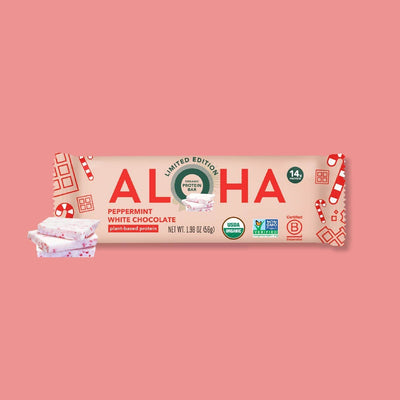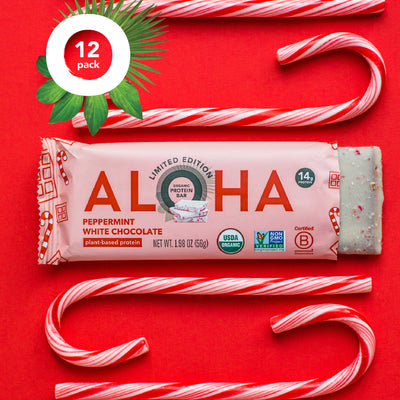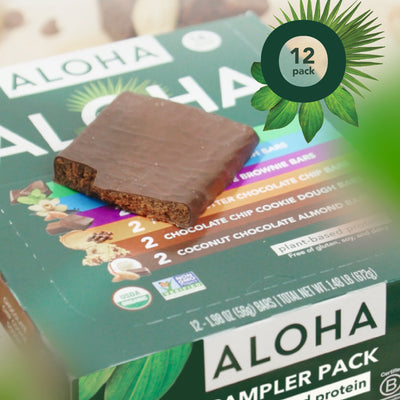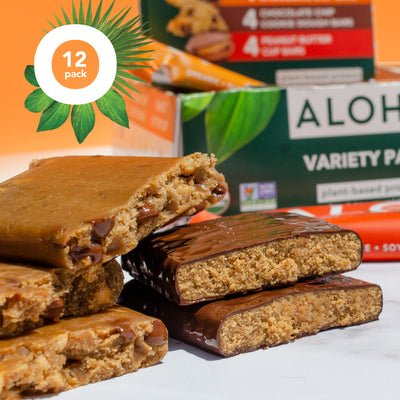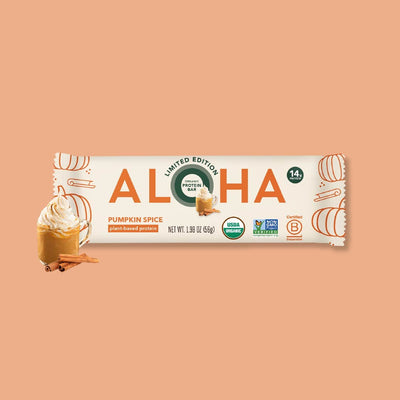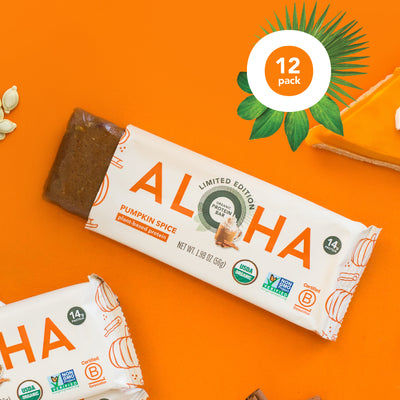Key Takeaways:
- Nutrient Focus: Clif Bars contain high levels of sugar and processed ingredients that may not suit everyday snacking needs.
- Clean Ingredient Value: ALOHA bars are made with organic, plant-based ingredients and offer lower sugar and more fiber per bar.
- Daily Choice Impact: Choosing snacks with whole food ingredients can better support long-term health and balanced energy.
Clif Bars have been a go-to snack for years. You’ll find them in backpacks, gym bags, and glove compartments almost everywhere. They’re marketed as energy boosters made for active people, but if you’ve ever turned one over and read the label, you might have wondered how healthy they really are. With ingredients like brown rice syrup and added sugar taking top spots, it’s fair to ask whether they belong in your everyday routine or just your hiking pack.
At ALOHA, we take a different approach. We believe food should fuel your body and align with your values. Our bars are made with real, organic ingredients, and we never compromise on quality. Everything we make is plant-based, non-GMO, and thoughtfully sourced. We’re not just here to fill you up. We’re here to help you feel good about what you’re eating. That’s the standard we hold ourselves to, and one we’re proud of.
In this piece, we’ll take a closer look at whether Clif Bars are actually healthy, how they compare to ALOHA, and what to consider when choosing a protein bar that supports your goals.
What’s in a Clif Bar?
Clif Bars were created to fuel endurance athletes, and their ingredients reflect that goal. A typical bar includes oats, brown rice syrup, soy protein isolate, roasted soybeans, cane sugar, and a blend of added vitamins and minerals. You’ll also see ingredients like vegetable oils, natural flavors, and added fiber in some varieties.
At first glance, it might seem like a balanced mix of carbs, protein, and nutrients. But sugar is a major part of the formula. Brown rice syrup is usually listed first, which means it is the most abundant ingredient by weight.
Some flavors contain up to 20 grams of sugar, which puts them close to the range of many candy bars. Clif Bars can work well for high-intensity workouts or long outdoor activities, but for everyday snacking, they may not be the most nourishing choice if you're aiming for something less processed and more balanced.
Are Clif Bars Healthy or Just Convenient?
Clif Bars are often seen as a healthy snack, but it depends on what your body needs and when you’re eating them. For someone finishing a long run or gearing up for a hike, the quick carbs and protein might hit the spot. But for everyday snacking or light activity, they may offer more than you need.
Many Clif Bars are high in calories, carbs, and sugar. That makes sense for endurance athletes who burn a lot of energy, but not everyone is reaching for a bar after training. If you're sitting at a desk or running errands, the nutrition profile might feel a little heavy.
Convenience is a big part of their appeal. They're easy to toss in a bag, and they feel like a smarter choice than chips or candy. But when a bar is packed with sweeteners and highly processed ingredients, it starts to look less like a health food and more like a high-energy treat. That’s where it helps to look a little closer at the label.
Understanding the Sugar Content in Clif Bars
Sugar plays a big role in the flavor and function of many Clif Bars. Some varieties contain up to 20 grams of sugar per bar, which is close to what you’d find in a standard candy bar. That sugar mostly comes from sources like brown rice syrup, cane sugar, and sometimes dried fruits.
Brown rice syrup is often the first ingredient listed, meaning it makes up the largest portion of the bar by weight. While it’s technically a natural sweetener, it behaves like other added sugars in the body and contributes to blood sugar spikes and crashes. For a quick energy boost, that might be fine. For regular snacking, it’s something to pay attention to.
The challenge is that many people reach for Clif Bars thinking they are a low-sugar, high-protein option. In reality, the sugar content is often higher than expected, especially if you're trying to manage blood sugar or support steady energy throughout the day. Reading the label carefully can help you make a more informed choice.
Clif Bars vs ALOHA: What’s the Nutritional Difference?
When comparing Clif Bars to ALOHA bars, the differences are clear. Both are marketed as convenient sources of energy, but the ingredients, sugar content, and overall nutrition tell very different stories.
Clif Bars often contain more than 40 grams of carbohydrates and around 20 grams of sugar. Their protein content sits around 9 to 11 grams, depending on the flavor. The bars are made with soy protein isolate and sweetened with brown rice syrup, cane sugar, or both. Many of the ingredients are processed, and most Clif Bars are not organic.
ALOHA bars take a different approach. Each bar is certified organic, plant-based, and made with whole food ingredients. They typically contain 10 grams of fiber, 14 grams of protein, and around 5 grams of sugar. The protein comes from a blend of pumpkin seeds and brown rice, not soy isolates. The sugar is kept low and is sourced from organic tapioca syrup and coconut sugar.
The result is a bar that feels more like real food than a packaged energy product. ALOHA bars are also free from artificial additives and made without dairy, gluten, or stevia. For people looking for something clean and satisfying without the sugar spike, that can make a big difference.
To learn more about what makes a quality snack, check out the blog post Are Protein Bars Good for You.
The Role of Ingredients in Long-Term Health
What you eat regularly matters more than what you eat occasionally. That’s why the quality of ingredients in your everyday snacks can have a long-term impact. While a sugary bar might give you quick energy, it may not support your overall health goals if it’s packed with highly processed ingredients.
Many bars on the market, including some popular options like Clif Bars, rely on refined sugars, syrups, and protein isolates to deliver flavor and function. These ingredients serve a purpose, especially in high-performance settings, but they are not always the best fit for daily nourishment.
Choosing snacks made from whole food ingredients can help you get more from each bite. Organic plant-based sources of protein, natural sweeteners in smaller amounts, and fiber-rich ingredients all support steady energy and better digestion. Over time, that adds up. Your daily choices play a role in how you feel, how well you recover, and how sustainable your eating habits become.
How to Choose the Right Protein Bar for You
The best protein bar is the one that fits your lifestyle, supports your goals, and feels good in your body. That might mean something higher in carbs and protein after a tough workout, or something lighter and more balanced for a mid-afternoon snack.
Start by checking the ingredient list. Look for whole food sources of protein, natural sweeteners in smaller amounts, and fiber that helps keep you full. Watch out for added sugars, artificial ingredients, and protein isolates if you're aiming for a cleaner option.
If you're reaching for bars often, it helps to think of them as part of your daily rhythm, not just an occasional backup. That’s where a bar like ALOHA can make a difference. With organic ingredients, balanced nutrition, and no hidden extras, it’s a choice that feels as good as it tastes.
What Makes ALOHA a Trustworthy Brand
Trust starts with transparency. At ALOHA, we believe that people should know exactly what they’re putting into their bodies. That’s why we use real, organic ingredients that are easy to recognize and even easier to feel good about. Every bar is certified USDA Organic, Non-GMO Project Verified, and made without gluten, dairy, soy protein isolate, or artificial sweeteners.
But it goes beyond the ingredient list. ALOHA is a Public Benefit Corporation and a Certified B Corporation, which means we’re legally committed to prioritizing people and the planet right alongside profit. We care about how our products are made, who makes them, and how our choices affect the world around us.
Our mission has always been to make healthy eating more accessible and more honest. That’s why we work closely with our farmers and suppliers, and why we continue to hold ourselves to higher standards. When you choose ALOHA, you’re not just picking up a protein bar. You’re supporting a company that puts integrity first.
Final Thoughts
Clif Bars have earned a reputation for being convenient and energy-packed, especially for active lifestyles. But when it comes to daily nutrition, it’s worth looking beyond the label. High sugar levels and processed ingredients make them better suited for specific situations rather than everyday snacking.
ALOHA offers a more balanced alternative. Each bar is made with organic, plant-based ingredients and contains less sugar, more fiber, and no artificial additives. That means you get steady energy and real nutrition without compromising on taste or values.
Choosing the right bar comes down to what matters most to you. If you're looking for something that supports long-term health and fits easily into your routine, ALOHA is a snack you can feel good about.
Read also:
- 8 Super-Delicious Protein Bars for Convenient On-the-Go Snacking
- Whey Protein vs Plant Protein: Which is Better for You?
- Ultimate Checklist: Choosing the Best Healthy Protein Bars
Frequently Asked Questions
Are Clif Bars considered a meal replacement?
Clif Bars are not intended to replace a full meal. While they offer calories and some nutrients, they lack the variety and balance of a complete meal.
Can Clif Bars help with weight loss?
Clif Bars are relatively high in sugar and calories, which may not align with most weight loss goals unless they’re used strategically around workouts.
Are Clif Bars safe for kids?
Yes, they’re generally safe for children in moderation, but the sugar content may be higher than what’s ideal for a child’s regular snack.
Do Clif Bars contain caffeine?
Most Clif Bars do not contain caffeine. However, some flavors, like those with chocolate or coffee ingredients, may include small amounts.
Are Clif Bars gluten-free?
Clif Bars are not certified gluten-free and are made in facilities that process gluten, so they’re not suitable for people with celiac disease or gluten sensitivity.
Are there vegan Clif Bar options?
Many Clif Bars are plant-based, but not all are certified vegan. Some may contain honey or other ingredients that don’t align with strict vegan diets.
Can Clif Bars be eaten before bed?
While safe to eat before bed, the high sugar and carbohydrate content might cause a spike in energy, which could disrupt sleep for some people.
Do Clif Bars expire?
Yes, like most packaged foods, Clif Bars have a printed expiration date. Storing them in a cool, dry place helps maintain freshness longer.
How do Clif Bars hold up in hot weather?
They can become sticky or soft in high heat due to ingredients like chocolate chips and syrups. They're still safe to eat but might get messy.
Are Clif Bars non-GMO?
Some ingredients in Clif Bars are non-GMO, but not all bars carry a full non-GMO certification. Check individual packaging for verification.
Sources:
1. Fabio Fanari, Josep Comaposada, Fatma Boukid, Climent, E., Anna Claret Coma, Guerrero, L., & Massimo Castellari. (2023). Enhancing energy bars with microalgae: A study on nutritional, physicochemical and sensory properties. Journal of Functional Foods, 109, 105768–105768. https://doi.org/10.1016/j.jff.2023.105768
2. Judit Tormási, Benes, E., Éva Lengyel Kónya, Berki, M., & László Abrankó. (2025). Evaluation of protein quantity and protein nutritional quality of protein bars with different protein sources. Scientific Reports, 15(1). https://doi.org/10.1038/s41598-025-94072-4





